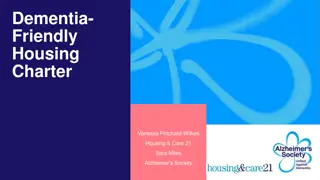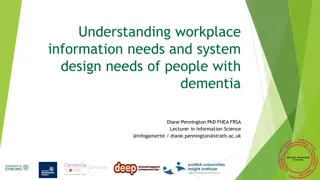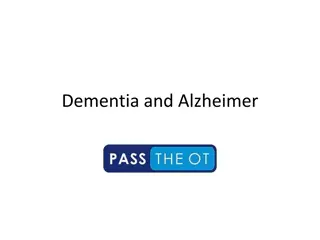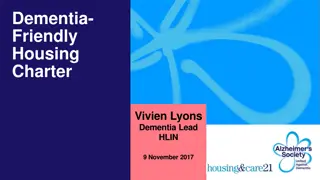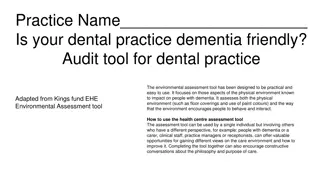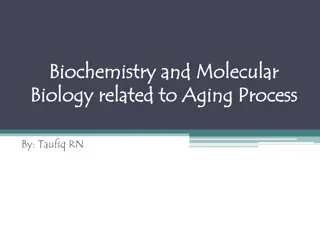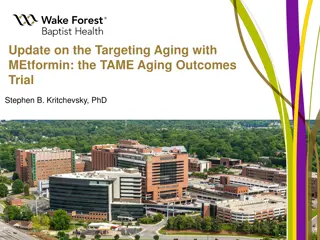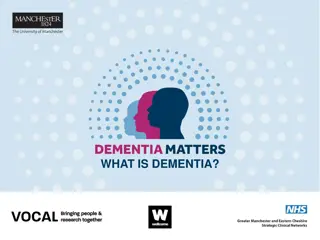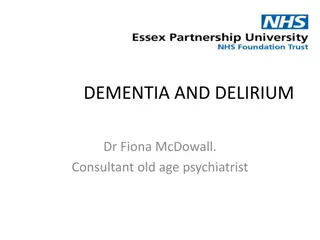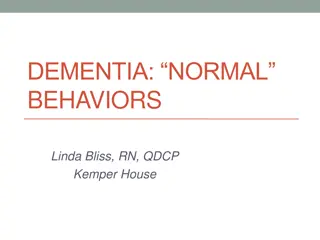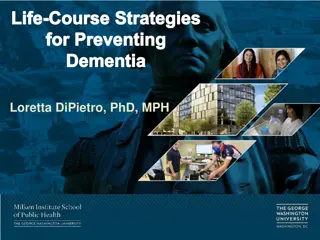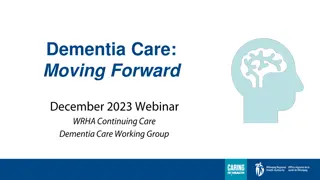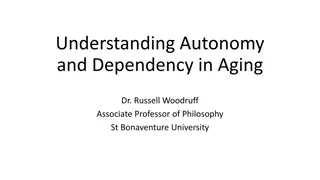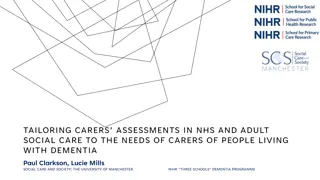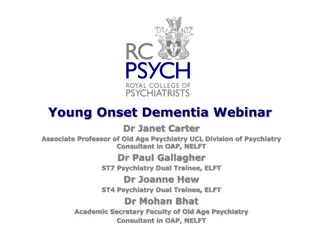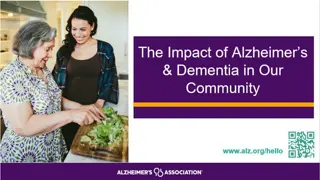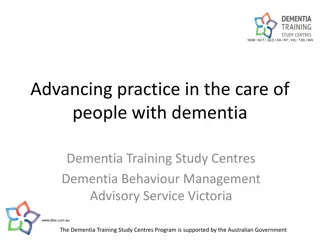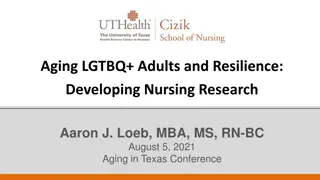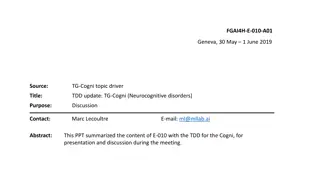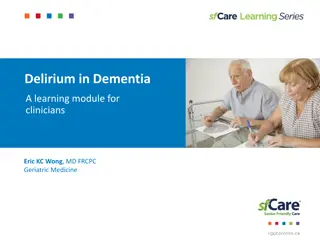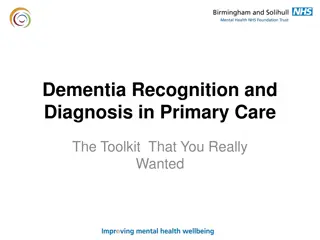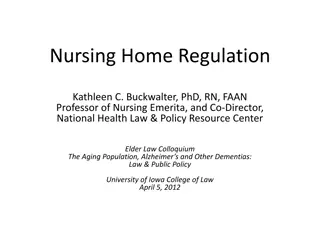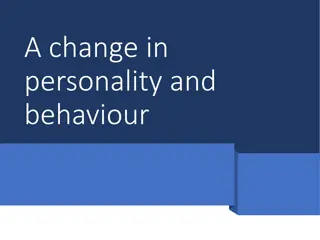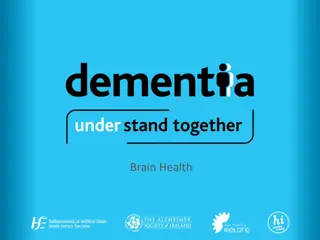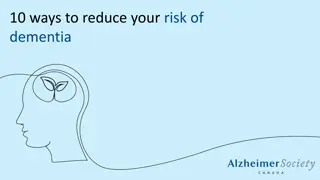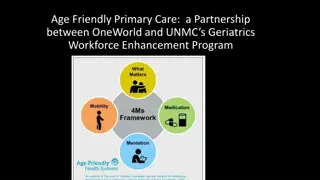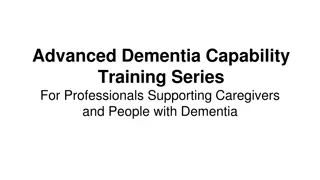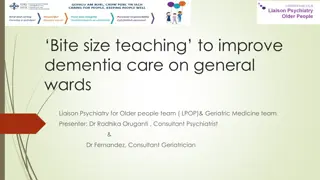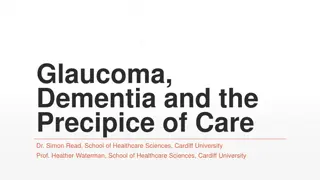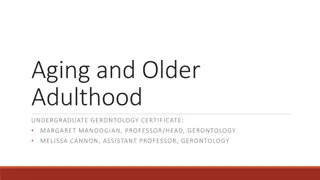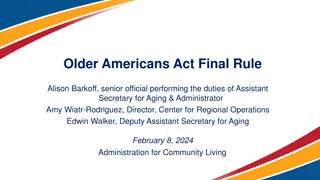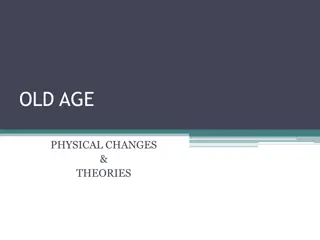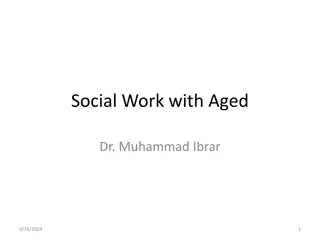Supporting Individuals with I/DD and Dementia in Aging
Highlighting the increased longevity of individuals with developmental disabilities, this resource sheds light on the challenges and statistics surrounding aging in this population. It covers insightful quotes, key facts, and risk factors contributing to decreased longevity, emphasizing the importance of support and care for aging individuals with I/DD.
Download Presentation

Please find below an Image/Link to download the presentation.
The content on the website is provided AS IS for your information and personal use only. It may not be sold, licensed, or shared on other websites without obtaining consent from the author. Download presentation by click this link. If you encounter any issues during the download, it is possible that the publisher has removed the file from their server.
E N D
Presentation Transcript
I/DD and Dementia: Supporting People with Developmental Disabilities During the Aging Process: Frederick Wetzel, Ph.D., LNC, NCC, Certified Dementia Practitioner Affiliated Regional Trainer National Task Group on ID and Dementia. Downstate Director (Ret.) OPWDD Division of Quality Improvement
Ideas Do not regret growing older. It is a privilege denied to many. Author Unknown.
Ideas The great secret that all old people share is that you really haven t changed in seventy or eighty years. Your body changes, but you don t change at all. And that, of course, causes great confusion. Doris Lessing.
Ideas We ve put more effort into helping folks reach old age than into helping them enjoy it. Frank A. Clark Old age ain t no place for sissies. Bette Davis.
Some Statistics/Facts 22% of the general population is currently age 60 and over. 22% of the general population will be over age 65 by 2040. Persons with I/DD are experiencing increases in longevity similar to the general population- due to improved medical care and sanitation, and their greater survival to adulthood
Some Statistics/Facts 6.5 million people in the U.S. have an ID (2019) Persons with I/DD in the U.S. age 60 or older estimated to be at 173,000 in 1995. An estimated 332,900 baby boomers were born between the years 1946 and 1964. Numbers of older persons with I/DD may double or triple by 2025. Average life expectancy for persons with I/DD , with some exceptions, is approaching same age as the general population.
Some Statistics/Facts Average life expectancy for persons with Down Syndrome has improved, yet is lower than persons with I/DD by 10-20 years, and the older population without I/DD. Average life expectancy with Down Syndrome in 1960 was 10 years and is now reported to be nearly 60 years and climbing .
Risk Factors for Decreased Longevity 1. Associated health conditions more commonly found for individuals with severe degree of ID (Severe-Profound), seizure disorder, or cerebral palsy. 2. Major medical problems (eg. chronic upper respiratory conditions, infections, cardiac conditions, choking) 3. Decreased mobility, toileting and eating skills.
Risk Factors Aging families-aging caregivers. An estimated 60% of persons with I/DD live with family. 25% live with caregivers aged 60 and older; 35% live with middle-aged caregivers Persons with I/DD may outlive older parents, and parental death or illness may precipitate a crisis whereby the individual requires rapid response by the service system.
Risk Factors Individuals may outlive programs (eg. Reach retirement age in work or day programs). Greater number of older persons with I/DD may be seen in generic health care settings such as primary care, senior and adult day health, home health care, emergency rooms and specialty clinics due to: Increased number of persons residing in community residential settings and independent environments.
Risk Factors Persons with I/DD are at greater risk due to: Early onset of age-related conditions (may be increased for syndrome-specific or neurodevelopmental disorders). Long-term progression of lifelong disability. Interaction of age-related conditions and lifelong disabilities (eg. Sensory aging changes compounded by earlier sensory pathology).
Risk Factors Older persons with I/DD acquire health conditions at higher rates than neuro-typical elders. This is attributable to factors related to syndromes, e.g.: Persons with Down Syndrome are at greater risk for developing Alzheimer s disease; Conditions such as sensory impairment, thyroid disease and non-ischemic heart disease have an increased prevalence in persons with I/DD.
Risk Factors Persons with I/DD are at risk for secondary conditions associated with the primary etiology of their disability (e.g., Pain, skin breakdown, functional incontinence, depression and anxiety, osteoporosis, emotional dependence, or abuse and neglect).
Risk Factors Persons aging with I/DD are at greater risk for medication issues, including poly-pharmacy, that may be due to earlier age-related sensitivity to medications; risks of adverse effects due to inability to communicate side effects or symptoms or ineffective reporting by informants; overmedication and inappropriately prescribed medications; or greater risks of medication interactions.
Risk Factors Health care may be restricted by a number of factors including lack of knowledge and training for health professionals about the health issues of persons with I/DD, and other barriers related to low social status and stigmatization.
Risk Factors Individuals with I/DD may experience grief and emotional trauma due to losses that might include: decline or loss in functional abilities from aging or chronic illness; loss of family, friends or support staff; residential transitions; changes in opportunities; or lack of choice making.
Aging in Place in Residential Settings Over 1/3 of people in long-term care facilities are age 50 or older. About 20% are 65 or older. One in ten have lived at least 3/4ths of their life in residential settings.
Aging with I/DD People with I/DD have the same goals and desires for aging as anyone else: Healthy aging and maintaining independence Emotional and psychological stability Personal and social control Continued engagement with life
Factors that complicate aging with I/DD The normal effects of aging Limited access to/inadequate funding for quality health care Negative attitudes about people with I/DD Lifestyle choices and opportunities Lack of knowledge about aging for people with I/DD Effects of the disability and its treatment
Other factors that complicate aging with an I/DD Decreased quality of life Absence of emphasis on healthy aging Aging adults with I/DD often have difficulty expressing changes in their health status. The risk of dementia.
Aging With a Developmental Disability Normal effects of aging Effects of the disability and its treatment Limited access to quality health care Lack of knowledge about aging for people with DD Inadequate funding for health care Person with a Disability Lifestyle effects Negative attitudes about people with disabilities Decreased Qualit y of Life
Support During the Aging Process Document current level of function. BASELINE Recognition of changes that need attention, especially in non-verbal Individuals e.g., dementia vs. more treatable problems Agency plan for aging in place or alternative care. End-of-life planning. End-of-life care.
Issues to Rule-Out Always rule out medical causes for maladaptive behaviors/psychiatric issues. Possibilities: Heart Disease. Symptoms may include dizziness, disorientation, memory and cognitive deficits
Issues to Rule-Out CVA/Stroke/TIA. Symptoms may include cognitive loss, short/long term memory loss, disorientation, loss of speech or ability to communicate, lack of comprehension of surroundings and the spoken word.
Issues to Rule-Out Hypothyroidism. Symptoms my include memory loss, lack of response, slowing down of response and recall time, cognitive loss, and lethargy.
Issues to Rule-Out Medication Side-Effects, Toxicity, errors. Symptoms may include disorientation, lethargy, stumbling gait, confusion, memory loss, slowed response time, lack of response to stimuli, and aggression.
Issues to Rule-Out Sensory Impairments. Hearing Loss: Symptoms may include lack of understanding and apparent inappropriate responses. Visual Loss: Symptoms may include inability to way-find; inability to name people they should know
OK: Its Dementia. What Now? Most Common: Alzheimer Disease. Cause: Abnormal build-up of proteins, building plaques and tangles in and around brain cells. Two main types: Early-Onset. May appear in 40s and 50s. High risk in Down Syndrome. Late-Onset: most common cause, generally age 65 and older.
Stages of Alzheimer Disease it is difficult to project the duration from diagnosis to death in AD. On average people with AD live between three and 11 years after diagnosis, but some survive 20 years or more. The degree of impairment and comorbidities at diagnosis can affect life expectancy. Pneumonia (aspiration) is one of the major causes of death due to the development of impaired ability to swallow.
Treatment Strategies Support and educate family caregivers. Recognize challenges faced by the caregiver. Change care focus. Going from making gains to that of maintaining as much function as possible and dealing with eventual loss and decline. Develop and emulate current models of care that anticipate the increasing support needs as dementia progresses.
Benefits of Early Diagnosis Manage symptoms of dementia. Maintain daily activities to the extent possible and preserve quality of life. Anticipatory guidance. Help offset caregiver stress. Maintain aging in place whenever possible and appropriate.
Treatment Strategies Treat co-existing medical conditions that may affect behavior or mental status (Pain, stress, immobility, increasing dependence). Maintain current levels of social support, build new sources as opportunity arises (geriatric day care, sitter services, etc).
Treatment Strategies Provide opportunities for social interactions. This helps to combat depression/maintain orientation Person-Centered planning processes are important for aging individuals.
Treatment Strategies Supporting caregivers is vital. Education of caregivers will promote understanding of the disease process/aging process. Teach caregivers to not take it personally , avoid power struggles , understand Individuals need to maintain a locus of control.
Treatment Strategies Teach Caregivers: Speak directly to the person Keep sentences short Use simple language Avoid slang their slang may not be up to date Speak slowly and clearly
Treatment Strategies Teach Caregivers: Give concrete directions Break complicated instructions down into smaller parts (preferably one-step) Use pictures, symbols and actions to convey meaning Be aware of hearing and vision issues Music (Their Music) is very useful and therapeutic
Treatment Strategies Teach Caregivers: Make eye contact. Use your name (Every time) Don t assume the person can t understand. But KEEP IT SIMPLE Be genuine in your desire to understand him or her Don t be rushed Adapt activities/schedules as needed.
Treatment Strategies Medication: Important to remember that medication should not be the first, or the only modality to manage behavior/psychiatric symptoms in aging individuals. When considering medications, they should be targeted to specific symptoms.
Treatment Strategies Keep the metabolic issues previously discussed in mind. Aging individuals may need much smaller doses to have the same effect. Start low and go slow Monitor carefully for side effects/adverse reactions.
??? Questions??? My Contact Info: Frederick Wetzel, Ph.D., LNC, CDP, LLC. 917-797-1824 wetzelfm@gmail.com I m available to provide training and consultation on request.




